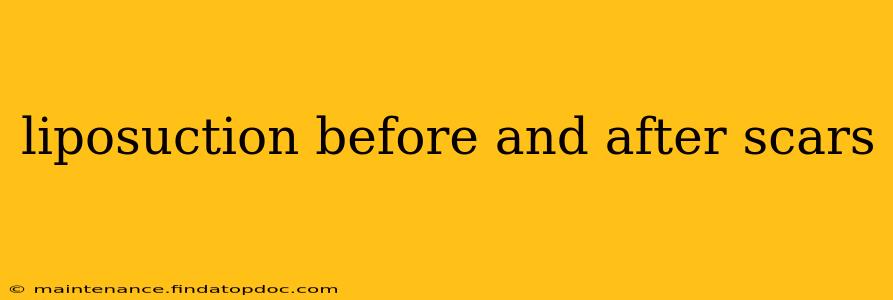Liposuction, a popular cosmetic procedure to remove excess fat, is often associated with positive before-and-after transformations. However, it's crucial to understand that like any surgery, liposuction can leave scars. While often minimal, the appearance and healing of these scars depend on various factors, including individual healing processes, the surgeon's technique, and post-operative care. This comprehensive guide explores liposuction scars, addressing common concerns and providing insights into what you can expect before, during, and after the procedure.
What Type of Scars Can I Expect After Liposuction?
The scars from liposuction are typically small, ranging from a few millimeters to a couple of centimeters. Their size depends largely on the extent of the procedure and the location of the incision points. Many surgeons use cannula insertion points that are small, resulting in barely noticeable scars. These incisions are usually strategically placed in areas naturally concealed, such as within skin creases or folds. Therefore, you may find they fade significantly over time.
The type of scar you develop can vary. Some people may experience:
- Fine, barely visible lines: This is the most common outcome, particularly with minimally invasive liposuction techniques. These lines often fade to become almost invisible over time.
- Slightly raised scars: These are less common but can occur. They usually flatten and become less noticeable as healing progresses.
- Hypertrophic scars: These are raised and thicker than normal scars. They're less common with liposuction but may be more likely in individuals prone to keloid scarring.
- Hypopigmented scars: These are lighter than the surrounding skin. They are generally not a cause for concern.
How Long Does it Take for Liposuction Scars to Heal?
Liposuction scar healing varies depending on individual factors and the size and location of the incisions. Generally, you can expect:
- Initial healing (1-3 months): During this phase, the incisions will close, and any swelling or redness will gradually subside.
- Scar maturation (6-12 months): In this period, the scar tissue will remodel, and its appearance will continue to improve. The scar will become softer, flatter, and lighter.
- Complete fading (12-18 months or more): Full fading of the scar is often achieved within a year or more. However, the scars may never completely disappear.
What Factors Affect Liposuction Scar Appearance?
Several factors can influence the appearance of your liposuction scars:
- Surgical technique: A skilled surgeon will use meticulous techniques to minimize scarring.
- Individual healing process: Your genetic predisposition and overall health can affect how quickly and effectively your wounds heal.
- Skin type: Individuals with darker skin tones may be more prone to hyperpigmentation (darkening) around the scar.
- Post-operative care: Following your surgeon's instructions meticulously concerning wound care will significantly affect scar appearance. This often involves keeping the incisions clean, dry, and protected.
- Sun exposure: Protecting your incisions from direct sunlight is vital in minimizing scarring and preventing discoloration.
- Smoking: Smoking can negatively impact wound healing, potentially leading to worse scarring.
How Can I Minimize Liposuction Scars?
While you can't entirely prevent scarring, there are steps you can take to minimize its appearance:
- Choose an experienced and board-certified plastic surgeon: This is paramount to ensure the best possible surgical technique and minimize complications.
- Follow post-operative instructions carefully: This includes keeping the incisions clean, using any prescribed creams or ointments, and avoiding activities that could stress the wounds.
- Protect scars from the sun: Use a high SPF sunscreen on your scars to prevent hyperpigmentation.
- Consider scar treatment options: Your surgeon may recommend treatments like silicone sheets, massage, or laser therapy to improve scar appearance. These are generally used after the initial healing period.
Are Liposuction Scars Permanent?
While liposuction scars can significantly fade over time, they're not typically completely invisible. However, with proper healing and aftercare, they often become barely noticeable. The ultimate appearance of your scars will depend on various factors as discussed above.
Can I Have Liposuction if I'm Prone to Keloid Scarring?
Individuals prone to keloid scarring should discuss their concerns with their surgeon before proceeding with liposuction. The surgeon may use techniques to minimize scarring, but there's a higher risk of noticeable scars. This is an important discussion to have, as expectations need to be realistic.
This information is for general knowledge and should not be considered medical advice. Always consult with a qualified plastic surgeon to discuss your individual needs and concerns before undergoing any cosmetic procedure.
